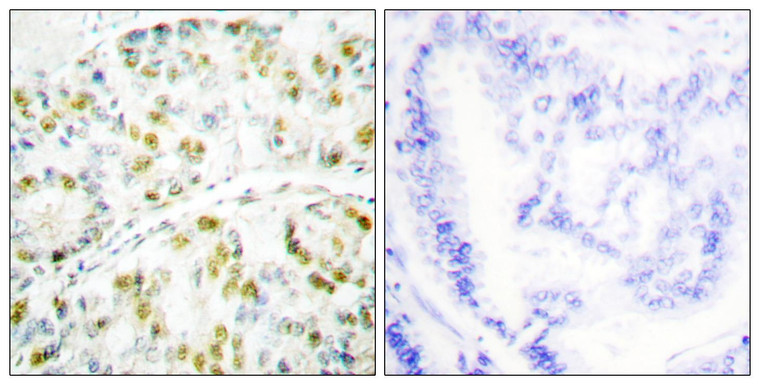| Host: |
Rabbit |
| Applications: |
WB/IHC/IF/ELISA |
| Reactivity: |
Human/Mouse |
| Note: |
STRICTLY FOR FURTHER SCIENTIFIC RESEARCH USE ONLY (RUO). MUST NOT TO BE USED IN DIAGNOSTIC OR THERAPEUTIC APPLICATIONS. |
| Short Description: |
Rabbit polyclonal antibody anti-Ataxin-1 (742-791 aa) is suitable for use in Western Blot, Immunohistochemistry, Immunofluorescence and ELISA research applications. |
| Clonality: |
Polyclonal |
| Conjugation: |
Unconjugated |
| Isotype: |
IgG |
| Formulation: |
Liquid in PBS containing 50% Glycerol, 0.5% BSA and 0.02% Sodium Azide. |
| Purification: |
The antibody was affinity-purified from rabbit antiserum by affinity-chromatography using epitope-specific immunogen. |
| Concentration: |
1 mg/mL |
| Dilution Range: |
WB 1:500-2000IHC 1:100-1:300IF 1:200-1:1000ELISA 1:5000 |
| Storage Instruction: |
Store at-20°C for up to 1 year from the date of receipt, and avoid repeat freeze-thaw cycles. |
| Gene Symbol: |
ATXN1 |
| Gene ID: |
6310 |
| Uniprot ID: |
ATX1_HUMAN |
| Immunogen Region: |
742-791 aa |
| Specificity: |
Ataxin-1 Polyclonal Antibody detects endogenous levels of Ataxin-1 protein. |
| Immunogen: |
The antiserum was produced against synthesized peptide derived from the human Ataxin 1 at the amino acid range 742-791 |
| Post Translational Modifications | Ubiquitinated by UBE3A, leading to its degradation by the proteasome. The presence of expanded poly-Gln repeats in spinocerebellar ataxia 1 (SCA1) patients impairs ubiquitination and degradation, leading to accumulation of ATXN1 in neurons and subsequent toxicity. Phosphorylation at Ser-775 increases the pathogenicity of proteins with an expanded polyglutamine tract. Sumoylation is dependent on nuclear localization and phosphorylation at Ser-775. It is reduced in the presence of an expanded polyglutamine tract. |
| Function | Chromatin-binding factor that repress Notch signaling in the absence of Notch intracellular domain by acting as a CBF1 corepressor. Binds to the HEY promoter and might assist, along with NCOR2, RBPJ-mediated repression. Binds RNA in vitro. May be involved in RNA metabolism. In concert with CIC and ATXN1L, involved in brain development. |
| Protein Name | Ataxin-1Spinocerebellar Ataxia Type 1 Protein |
| Cellular Localisation | CytoplasmNucleusColocalizes With Usp7 In The Nucleus |
| Alternative Antibody Names | Anti-Ataxin-1 antibodyAnti-Spinocerebellar Ataxia Type 1 Protein antibodyAnti-ATXN1 antibodyAnti-ATX1 antibodyAnti-SCA1 antibody |
Information sourced from Uniprot.org
12 months for antibodies. 6 months for ELISA Kits. Please see website T&Cs for further guidance









